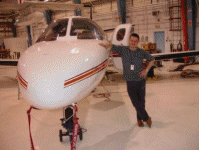
- Home
- Staff & Contacts
- Visitors & Guests
- Research Groups
+ Atmospheric Remote ...
Atmospheric Remote Sensing
+ Airborne trace gas ...Airborne trace gas measurements and mesoscale modelling
+ Inverse data-driven ...Inverse data-driven estimation
+ Integrating surface- ...Integrating surface-atmosphere Exchange Processes Across Scales - Modeling and Monitoring
+ Tall Tower Atmospheric ...Tall Tower Atmospheric Gas Measurements
+ Carbon Cycle Data ...Carbon Cycle Data Assimilation
+ Satellite-based remote ...Satellite-based remote sensing of greenhouse gases
- Projects
- + Models
- Publications
- PhD & Diploma Thesis
- Lectures at FSU
- Seminars
- Events
- Download
- Internal

|
Christoph Gerbig
Phone: + 49 3641 576373
|
Research Focus:
Airborne trace gas measurements and their application to biogeochemical cycles
Research Interests:
My main interest is to make atmospheric measurements of trace gases relevant for our earth's climate, and to utilize these data in combination with transport models to learn about sources/sinks of those gases, most prominently of CO2. On the experimental side this involves high accuracy measurement of trace gases from airborne platforms, but also development and optimization of such instrumentation. On the theoretical side it involves development of analysis tools such as mesoscale tracer transport models coupled to surface flux models. (more)
To cover these activities I have started the research group Airborne Trace gas measurements and mesoscale Modelling (ATM).
Research Activities:
Experiments
One of the pillars of my research is the development and deployment of instrumentation for measurement of trace gases from airborne platforms at a high accuracy.
- CO
- CO2
- Flask Sampler
- O2/N2
Theory (Model development)
A number of modeling tools are in development in a continued collaboration with the Wofsy group at Harvard and with John Lin (formerly at Harvard, now at Waterloo). These tools are elements of a model-data fusion system designed to extract information from a variety of data streams, with special emphasis on airborne or ground based accurate trace gas measurements.
STILT (Stochastic Time Inverted Lagrangian Transport model): A fast tool to retrieve the tracer adjoint (sensitivity of atmospheric tracer mixing ratio measured at receptor point with respect to upstream variations in surface fluxes), including turbulence. This is also used in forecast mode for flight planning purposes (examples).
VPRM (Vegetation Photosynthesis and Respiration Model): A diagnostic biosphere model to compute fluxes consistent with fluxes observed by Eddy Covariance. VPRM is a light use efficency (LUE) model, and uses the MODIS EVI (enhanced vegetation index) and LSWI (land surface water index) as well as vegetation classification (e.g. Synmap). Four parameters are optimized against measurements for each vegetation type. This work is in collaboration with Steve Wofsy at Harvard.
STILT-VPRM (STILT coupled to VPRM): A prototype framework to assimilate information from multiple data streams for retrieving regional fluxes. It couples STILT to boundary conditions such as fossil fuel inventories, biospheric fluxes (VPRM) and boundary conditions (model or data based for CO2, CH4, H2, and CO).
WRF-VPRM (Weather Research and Forecasting model coupled to VPRM): Coupling of WRF and VPRM for high resolution forward modelling of CO2. A fully scalable modelling approach ranging from mesoscales at 2 km to 20 km or coarser.
WRF-STILT (Weather Research and Forecasting model coupled to STILT): Consistent coupling of WRF transport to the STILT model, by using consistent mass fluxes (advective and convective) as well as consistent turbulence parameters. This work is in collaboration with Janusz Eluskiewicz at AER.
BRAMS-STILT (Brazil-Regional Atmospheric Modeling System coupled to STILT): Consistent coupling of RAMS transport to the STILT model, by using consistent mass fluxes (advective and convective) as well as consistent turbulence parameters. This work is in collaboration with Saulo Freitas and Marcos Longo at USP.
Presentations (selected):
Recent developments in atmospheric measurements, keynote presentation held at the IMECC Annual Workshop, Jena, Germany, March 3-5, 2008 (more)
Atmospheric constraints on greenhouse gas budgets: Requirements on modelling tools based on multiple observations, seminar given in the seminar series of environmental science and engineering at EPFL, Lausanne, 2008 (more)
Bridging carbon cycle scale gaps: lessons from CarboEurope, Plenary talk held with Markus Reichstein at the 6th Annual CarboEurope-IP Meeting, Jena, 29 September - 3 October 2008 (more)
Scaling carbon budgets from point to region using atmospheric constraints, Lecture held as Keynote Speaker at the OzFlux Annual Meeting, Barossa Valley, Southern Australia, 2008.
High-resolution simulations of atmospheric CO2: requirements for inverse modelling tools, European Geosciences Union General Assembly, Vienna, Austria, 2008.
Atmospheric constraints on carbon budgets at regional scales from airborne and ground based measurements, Global Change Seminar,University of Edinburgh, Edinburgh, UK, 2007.
Atmospheric Fingerprints of the Biosphere: Combining Top-down with Bottom-up Constraints, Lecture held at the Instituts Symposium 'Earth System Dynamics: Biogoechmical Perspectives', Max-Planck-Institute for Biogeochemistry, Jena, Germany, 2007.
Lagrangian inverse modelling of C-fluxes or Can we close the gap between model and measurement?, CarboEurope Spring School on Mesoscale processes in the carbon cycle, Heidelberg, Germany, 2006.
Regional scale CO2 budget constraints from concentration and flux measurements, CarboEurope open Science Conference, Crete, Greece, 2006.
Reality vs. Wishful Thinking - On the Gap between Measurements and Models in Carbon Cycle Research Joint Atmospheric-Chemistry Seminar of the ICG, Research Centre Jülich, Germany, 2005.
Regional Flux Estimates based on Inverse Modeling of Atmospheric Tracer Distributions: On the interplay between Models and Measurements, 2nd CarboEurope-IP Integrated Project Meeting, Dublin, Ireland, 2005.
The use of airborne and groundbased atmospheric observations in carbon cycle research, Lecture held at the ECMWF Seminar on Global Earth-System Monitoring, European Centre for Medium Range Weather Forecasting, Reading, UK, 2005.
Receptor-oriented tracer modeling: applying assimilated meteorological products in a quantitative framework to derive surface fluxes from atmospheric measurements of CO2, AGU Fall Meeting, pp. 08, 2002.
Quantification of Regional and Continental Scale Surface Fluxes of Carbon Using Airborne Measurements in a Lagrangian Framework, AGU Spring Meeting, 2001.
Development of a Simple Trajectory Transport Model to Assess Regional CO2 Fluxes From Aircraft and Tower Measurements, AGU Fall Meeting, 1999.
Collaborations:
Collaborations:
- Steve Wofsy (Harvard)
- John Lin (Univeristy of Waterloo)
- Janusz Eluszkiewicz, Thomas Nehrkorn (AER)
- Arlyn Andrews (NOAA GMD ESRL)
- Colm Sweeney
http://www.ldeo.columbia.edu/~csweeney/ (NOAA GMD ESRL)
- Andreas Volz Thomas (ICG-2, Research Centre Jülich)
http://www.fz-juelich.de/icg/icg-2/homepage/
- Uwe Rascher (ICG-3, Research Centre Jülich)
http://www.fz-juelich.de/icg/icg-3/
- Han Dolman (Vrije Universiteit Amsterdam)
http://www.vuamsterdam.com//home/index.cfm
- Paulo Artaxo (USP)
http://www.usp.br/
- Karla Longo (CPTEC-INPE)
http://www.cptec.inpe.br/
